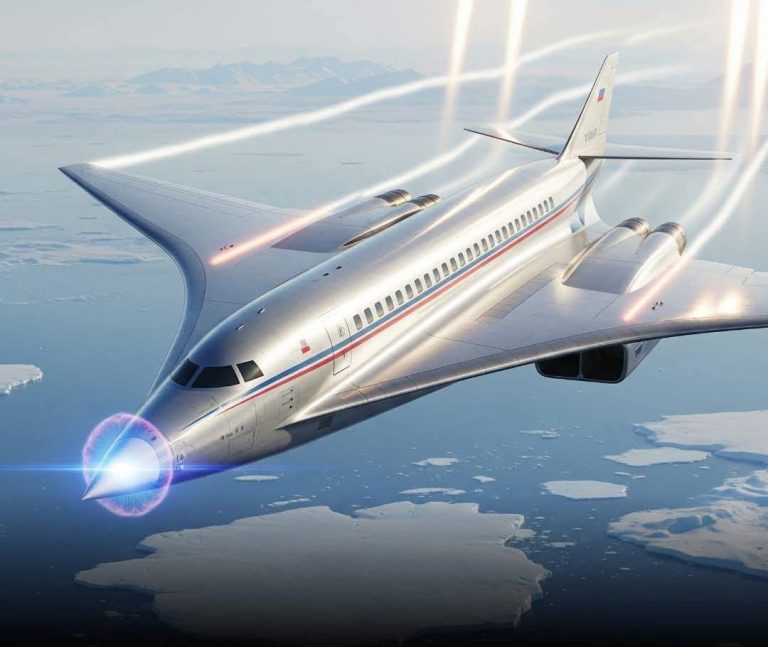Russian engineers have just tested a hypersonic passenger aircraft prototype that can fly from Moscow to New York in under two hours — without producing a deafening sonic boom. Built by the Central Aerohydrodynamic Institute (TsAGI) in partnership with several aerospace startups, the aircraft, nicknamed Strizh (“Swift”), uses a revolutionary “shockwave-canceling” fuselage design that manipulates airflow to muffle the sound normally generated when breaking the speed of sound.
The plane’s body is shaped like an elongated diamond with a hollow central channel that redirects and diffuses pressure waves before they hit the ground. Combined with an active plasma field generator at the nose, it alters the density of the surrounding air, reducing drag and allowing speeds up to Mach 6 — nearly 7,400 km/h. During its first high-altitude flight over the Arctic, test pilots reported that the cabin was surprisingly quiet, with turbulence reduced to a gentle sway.
Strizh’s engines are equally unconventional: hybrid scramjets fueled by a synthetic hydrogen blend that produces only water vapor as exhaust. To avoid the extreme heating that destroys most hypersonic vehicles, engineers used a skin made from a titanium-graphene composite with embedded micro-channels for liquid nitrogen cooling. This keeps the surface temperature hundreds of degrees lower, even at blistering speeds.
One of the most striking features is its vertical takeoff and landing system. Instead of needing a massive runway, Strizh uses a cluster of vector-thrust boosters that lift it into the upper atmosphere before the scramjets ignite. This means it could operate from smaller airports worldwide, potentially bringing hypersonic travel to dozens of cities without major infrastructure changes.
If commercialized, this technology could redefine global travel. Business trips across continents could be completed before lunch, and cargo deliveries that take days today could arrive in hours — all while producing less environmental impact than conventional long-haul jets.
Russian engineers have successfully tested a groundbreaking hypersonic passenger aircraft prototype named Strizh (“Swift”), capable of flying from Moscow to New York in under two hours without producing the typical deafening sonic boom. Developed by the Central Aerohydrodynamic Institute (TsAGI) in collaboration with several aerospace startups, Strizh features a revolutionary “shockwave-canceling” fuselage that manipulates airflow to muffle the sound caused by breaking the sound barrier.
The aircraft’s design is an elongated diamond shape with a hollow central channel that redirects and diffuses pressure waves, preventing them from reaching the ground. At the nose, an active plasma field generator alters the surrounding air density, reducing drag and enabling speeds up to Mach 6 (approximately 7,400 km/h). Test pilots reported that the cabin remained surprisingly quiet during a high-altitude Arctic flight, with turbulence reduced to a gentle sway.
Strizh’s propulsion system is innovative as well, using hybrid scramjets powered by a synthetic hydrogen blend that emits only water vapor as exhaust. To withstand the extreme heat generated at hypersonic speeds, its skin is made from a titanium-graphene composite embedded with micro-channels for liquid nitrogen cooling, maintaining surface temperatures hundreds of degrees lower than usual.
Another remarkable feature is its vertical takeoff and landing (VTOL) system, employing vector-thrust boosters to lift the plane into the upper atmosphere before the scramjets engage. This capability allows Strizh to operate from smaller airports worldwide without requiring massive runway infrastructure.
If commercialized, Strizh could revolutionize global travel, enabling business trips across continents to be completed before lunch and transforming cargo delivery by reducing transit times from days to hours — all while minimizing environmental impact compared to conventional long-haul jets. This technological breakthrough heralds a new era of fast, eco-friendly air travel.


